The history of Apple's M-series chip launches is also the history of Intel chips lying around, as was the case with the M2 chip launch at WWDC22 this time around.
According to Apple, the M2 delivers nearly two times the CPU performance improvement over the latest 10-core PC notebooks for the same power consumption; plus, the M2 consumes a quarter of the power of a PC chip for the same performance.
Even in the latest 12-core PC notebooks, the M2 chip delivers nearly 90 percent of the peak performance of a 12-core chip with only a quarter of the power consumption.
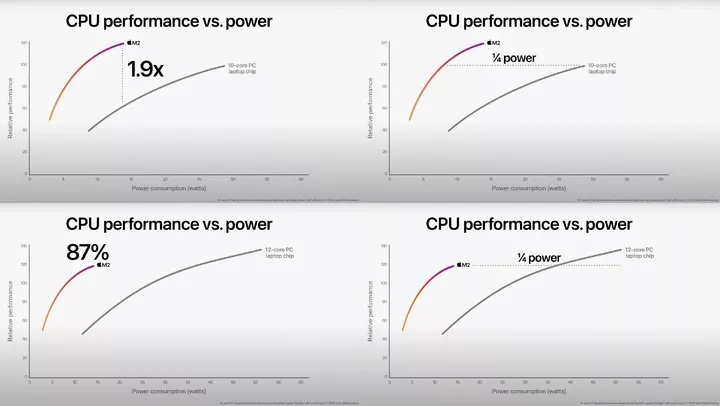
Similarly, on the GPU side, the M2 chip offers a 2.3x increase in peak performance over the integrated graphics in the latest 10-core PC notebooks, while the M2 GPU reaches the other side's maximum performance with one-fifth the power consumption.

At first glance these score numbers show that Apple's homegrown M-series processors are beating Intel's overall performance by several generations, but the situation may be a little more complicated than these charts.
M2 is powerful, but 12th Gen Core is no 'slouch' either
In fact, the latest 10-core PC laptop that Apple is talking about refers to the Samsung Galaxy Book2 360 (16GB RAM) with a Core i7-1255U processor. With the same 15W power consumption, the M2 chip delivers 1.9 times the CPU performance of the i7-1255U with two fewer cores.
The latest 12-core PC notebook is the MSI Prestige 14Evo (16GB RAM) with a Core i7-1260P processor. By comparison, the M2 chip delivers 87% of the CPU performance of the i7-1260P (28W) with only 7W of power consumption.
Looking at the GPU section, again comparing the Samsung Galaxy Book2 360 (16GB RAM), the M2 gets 2.3x the performance of the i7-1255U with only 3W of power consumption.
The M2 chip does outperform the Core i7-1255U and i7-1260P in terms of power consumption, but that doesn't mean that the M2 CPU can outperform Intel's 12th generation Cores across the board.
As we all know, Intel chips are divided into several product lines, such as the H series, which is usually equipped with high-performance gaming notebooks; the U series, which represents low power consumption and is mainly used in modern thin and light notebooks; and the Y series, which refers to ultra-low voltage and is equipped with the 2020 MacBook Air.
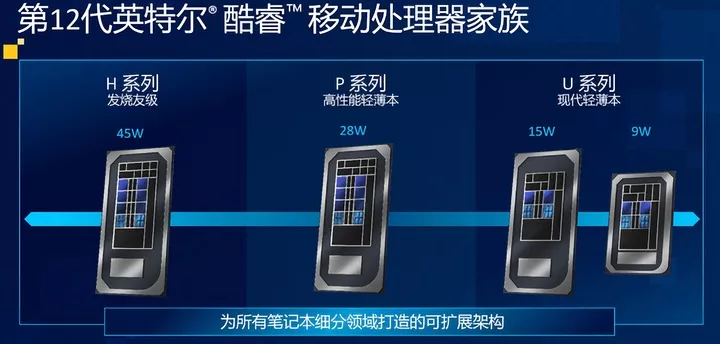
That said, Apple's M2 chips just outperform Intel's 12th Gen Core U and P series, giving it an almost complete lead in the thin and light notebook space. However, the M2 CPU is weaker than the former when it comes to the 12th Gen Core H-series processors. After all, the M2 is only 87% of the CPU performance of the i7-1260P when compared to the i7-1260P, regardless of power consumption.
For the GPU part, Apple says that the M2 chip can run Resident Evil 8 smoothly at 1080P resolution.
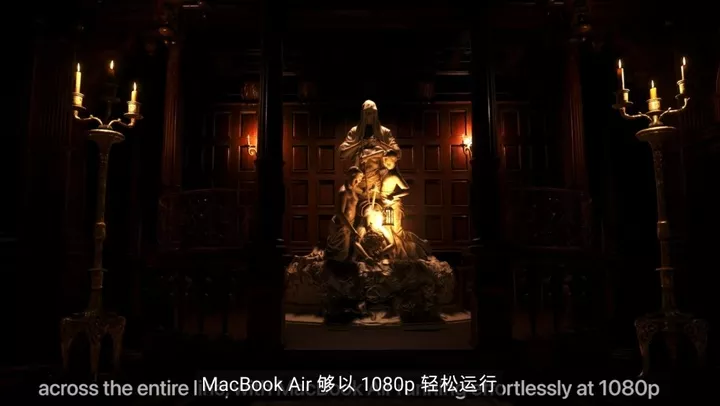
Steam shows that the game requires a graphics card of at least GTX 1050 Ti (4GB) to be able to run at 1080P 60 FPS. By that logic, the GPU performance is at least on par with the GTX 1050 Ti (4GB), without taking into account Capcom's game optimization for the M2 chip.
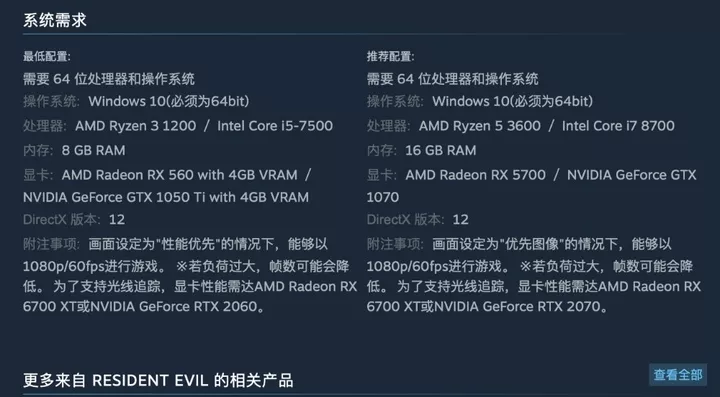
On Intel's side, even the top-of-the-line gaming notebooks with the i9-12900H and built-in Xe Graphics G7 96EU cores are only sandwiched between the AMD RX Vega 8 and GTX 660 in terms of performance.
So it seems that the M2 chip GPU performance is, arguably, ahead of Intel's 12th generation Core cores across the board.

So it's not accurate to say that Apple's M2 chips outperform Intel's Core 12 across the board. All that can be said is that the M2 CPU is better than Intel's Core 12 U-series chips, the GPU performance is ahead of Core 12 cores across the board, and the overall performance is better than the Core 12 U and P-series.
Intel 'bound' by conditions
Compared to Apple, Intel is more like a long-distance runner strapped to a sandbag, with each sandbag representing a constraint.
From the perspective of the market, Apple is mainly for high-end consumer groups, while Intel is more like a teacher in the school, need to take care of many students, such as low-end netbooks , mainly for those with limited budgets, not playing games users; students and office workers will give priority to mid-range thin and light notebooks; for the love of games, the pursuit of the ultimate performance of gamers prepared for the gaming notebook; and even for the enterprise mobile workstations.
The bottom line is that there are only a handful of chips used in Apple's Mac line. By way of comparison, Intel releases dozens of processors each year, available to each of the traditional PC manufacturers.
The limitations of chip types and numbers, the limitations of various user needs, and the limitations of chip supplier status do not allow Intel to throw its weight around and invest all of its R&D funds and talent in chip design.

In fact, Intel chip design isn't that bad. Take the 12th generation Core Alder Lake-H series, for example, Intel's first laptop chip with a hybrid architecture that uses the Intel 7 process, which is actually the industry's prevailing 10 nm process.
Intel says the Core i9-12900HK, with six 5GHz high-performance cores and eight efficient cores, delivers 50% more CPU performance than the M1 Max.
But on the mobile side, power consumption is an important metric. The Core i9-12900HK has a minimum guaranteed power consumption of over 35 W, much higher than the M1 Max's 20 W. Translated, the Core i9-12900HK requires nearly twice the power consumption to deliver 50% more performance than the M1 Max.
Theoretically, it is an indisputable fact that Core i9-12900HK CPU is better than M1 Max, but it is hard to say that Core i9-12900HK CPU performance can fully suppress M1 Max when energy consumption ratio is taken into account.
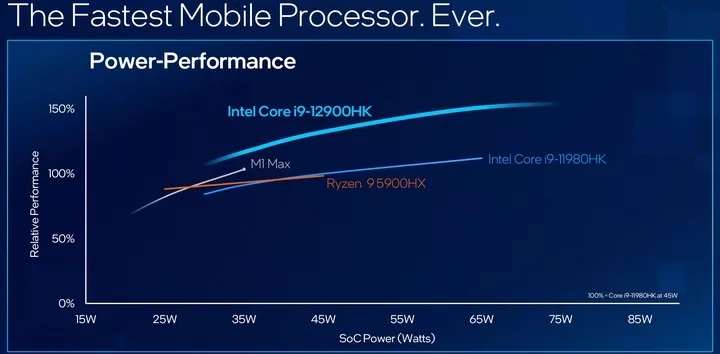
The reason for the low power consumption and high performance of Apple's M series chips is actually related to the process technology and the lack of compatibility "baggage" with the ARM architecture.
As an example, the M2 uses TSMC's second-generation 5 nm process, while Intel is still using the 10 nm process. The process determines how many transistors per unit area, and how many transistors determines the performance of the chip - there's no getting around the laws of physics.
Intel did not use the 5nm process on the chip because its own factory can only do 10nm, if you find Samsung, TSMC foundry, its costs will inevitably increase. Apple did not produce the chip factory, only involved in the chip design, the chip output is mainly responsible for TSMC.

Another secret to the low power consumption of Apple's M-series chips is that the ARM architecture eliminates designs that seem useless in modern times.
Intel's X86 series CPUs are famous for their great compatibility.
For example, in order to be compatible with the Intel 386 series CPU instruction set, an indeterminate instruction set IA-32 is built in, which is less efficient than ARM's indeterminate instruction set, resulting in a lot of useless work and ultimately an increase in CPU power consumption.
In the case of TSS task hard switching, mainstream operating systems no longer use IA-32 for the task hard switching mechanism and have largely switched to software, yet this complex set of instructions still remains in IA-32.
In other words, Intel kept a lot of old-world designs inside the X86 family of CPUs for compatibility purposes, including 8086 compatibility mode, obsolete instructions, redundant flag bits, non-uniform addressing, etc.
IA-32 has many historical legacy issues, such as expensive memory chips that cause many instructions to need to do as much as possible, and the fact that many function points cannot be removed once added for compatibility reasons, which inadvertently results in paying for some of the power consumption of these obsolete and useless designs, as well as further increasing the complexity of the X86 architecture's instruction set.
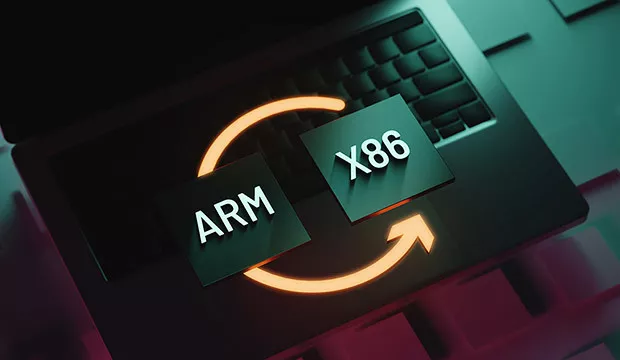
As such, these aforementioned constraints are more of a 'stumbling block' to Intel's ability to launch a more powerful and lower power chip than Apple's M-series than the two tech giants' chip design capabilities.
Apple, a 'boulder' in Intel's heart
After seeing Apple's M-series chips shine, Intel naturally won't just sit back and wait, using sky-high salaries to recruit people and even directly "poaching" Apple.
Earlier this year, Jeff Wilcox, former Director of Mac Systems Architecture at Apple, announced on the Collage job board that he was leaving Apple and taking a position at Intel, primarily as Technical Director of Intel's Academics and Design Engineering Division.
Jeff Wilcox spent eight years at Apple, where he undoubtedly made a significant contribution to the transition of the Mac line from Intel to Apple Silicon. Jeff Wilcox's departure is symbolic of the heated battle for talent between Intel and Apple.
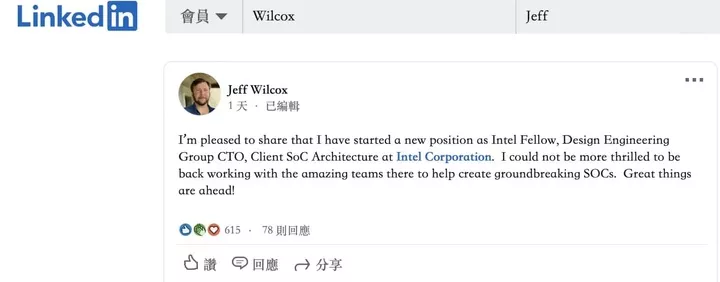
Apple has also taken a number of steps to retain its talent. According to Bloomberg, Apple is giving bonuses in the form of restricted shares to some of its employees in the software and hardware engineering departments. The bonuses range from $100,000 to $200,000 and are referred to internally by Apple as 'special retention awards'.
In addition to the bonuses, Apple said in its latest statement that it intends to increase its overall compensation budget this year in order to encourage and retain the best team members in the world. Among the retail store employees, the hourly rate has been increased from $20 to $22, an annual increase of 10%.
This shows that Apple's M-series chips have really caught Intel's attention, and the 12th generation Core is the best proof of Intel's response to this challenge of Apple's M-series chips.